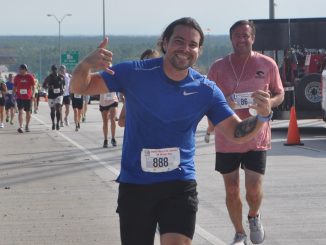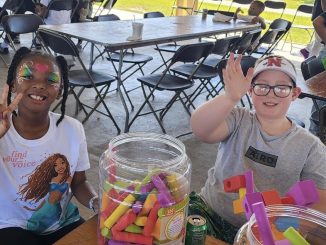
Martha Davis was not always deaf.
The 62-year-old South Carolina native only began to lose her hearing after she got married and left college.
“I had measles multiple times as a child and high fevers. Measles causes deafness and blindness, but it hit me as deafness,” she said. “I didn’t go deaf until I was in my 20s.”
At first she did not even realize she had a hearing problem. It was not until her husband scheduled an appointment with an ear doctor that she knew something was wrong.
“I didn’t have any clue that I was going deaf. It doesn’t hit you that you are not hearing it, because you are not hearing it,” she said.
Following a battery of hearing tests, her doctor found she had severe nerve damage that was irreparable and could not be helped with assistance from hearing aids.
Despite the diagnosis, Davis remained upbeat and enthusiastically threw herself into lip reading school.
“You had to take somebody with you, so I dragged my husband and we did the lip reading school together,” she said. “I became so good most people didn’t know I was deaf.”
Davis did not lose her hearing all at once, but slowly. It began with no longer being able to hear very high-pitched sounds and progressed to where she could only hear low-pitched sounds and vibrations. However, she continued to work as a bank teller, a job in which she excelled for a decade.
“The customer is in front of you so you can read their lips,” she said. “I was a teller for about four or five years and then I became the head teller, which is where you are pulled off the line and I only had to deal with other tellers.”
It was not until she had children that she stopped working. By the time both of her sons had been born she could not hear them talk, but a series of devices helped her manage the household.
“We had monitors in their rooms and the living room,” she said. “For a while I could use the telephone, but I couldn’t hear it ring. I had amplifiers on it where I could hear part of what most people said.”
In the early 80s, a new hearing aid was developed that she tried, but the results were not satisfactory.
“That only lasted a couple of months,” she said. “Hearing aids pick up everything. The parts I could still hear were drowned out by picking up what I couldn’t hear, so it still didn’t do any good.”
Still, the failure of the hearing aids did not bother her due to her adeptness at reading lips.
So when the family moved to St. Charles Parish 26 years ago, Davis decided she would return to work. She said the idea of not working and collecting disability never occurred to her.
“I never looked into that. I never considered my self disabled,” she said. “Never.”
She started off as a substitute teacher, but after a year moved into teaching at Holy Family Preschool in Luling.
“The director said, ‘Well, I can give you a job as a music teacher.’ I asked, ‘How am I going to do music?” She said that if I could run a record player, the kids will sing to it and it won’t matter (if I hear them). So I took that job.”
Within a few years, Davis would rise through the ranks, becoming a teacher and then the director of the preschool. Twenty-four years later, Davis is still working at Holy Family.
Ten years into her tenure, she had a deaf child come through with a cochlear implant. She had heard about the technology in the late 80s, but by the late 90s the technology was still not very advanced.
“Back then he wore a backpack with the processor on his back and then it connected to his head,” she said.
Despite goading from her husband, she was skeptical about looking into an implant for herself.
“The Internet wasn’t a big thing back then so there was no real way to research it. I thought they were going into your brain. There is no way someone is going into my brain, so I wouldn’t even consider it,” she said.
It was not until her son’s fiancé, who is deaf in one ear, looked into an implant for herself that Davis fully explored the possibility at her son’s urging.
“He called and said, ‘Mom, they told me you are a perfect candidate. You really, really should try it before you die. Wouldn’t you like to hear again?’ I guess it just finally hit me that I am not the only one it affects,” she said.
So Davis began researching the implant options for herself.
“I went online and I researched it in detail and then I watched the operation on Youtube,” she said. “I saw they wouldn’t go into your brain at all. It is strictly your skull on the outside where they attach it.”
On Oct. 8, Davis underwent surgery for a cochlear implant.
“They cut you behind your ear and then they go in and they bore out a little tunnel in your skull,” she said.
Now, Davis has completely healed and the implant is little more than bump hidden under her hair and over her left ear. Davis also wears a processor that includes a magnet and microphone that pick up sounds and transmit them through wires that go directly into her cochlea in her middle ear and shock the nerve.
It was her oldest son’s birthday when the implant was first switched on and his was the first voice she heard. She said it was a very emotional experience.
“This is when they first turned it on and I’m hearing my son,” she said. “I thought I’d always heard my son. I was reading lips so long that when he would talk my brain thinks I am hearing.”
However, Davis said when the device was first installed it was very difficult to hear voices.
“When they first put it on, voices it picked up were like Darth Vader. I could tell people were talking, but I still had to see their lips,” she said.
For two weeks, she used a loaner processor they gave her before switching over to a newer version that changed the way the implant picks up noise using a process called remapping. That made it easier for her to understand the sounds she was hearing.
“They remapped it and when she turned it on she told my husband to speak to me,” she said. “When she turned it on he said ‘Martha!’ and I said ‘yes!’ and he said, ‘Can you hear me?’ and I said ‘yes!’ and I cried…it was very, very emotional.”
Although she can now hear again for the first time in 40 years, it will take time for the implant to function optimally.
“It comes in, but it is just a mechanical tone. It is the only way I know how to explain it, it is just weird,” she said. “It takes about a year for you to get the full benefit and for your brain to figure out the sounds. It has been 40 years since I could actually hear and it just takes time. I just have to be patient.”
In addition to hearing her own children for the first time, she can now hear the children at the preschool as well.
However, it is sometimes just the smallest things that make her happy for having gone through with the procedure.
“I was sitting at the picnic table outside and we have a big tall bush on the side of the table and a bunch of birds flew over and one landed right above me. I looked up and it looked down and said ‘chirp!’ and I said, ‘Oh Lord, I heard the chirp,” she said.




Be the first to comment